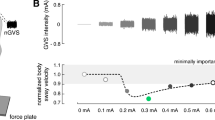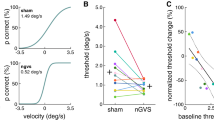Abstract
Objectives
To examine the mechanism underlying previously reported ameliorating effects of noisy galvanic vestibular stimulation (GVS) on balance performance in patients with bilateral vestibulopathy (BVP) and determine those patients (incomplete versus complete vestibular loss) that might benefit from this intervention.
Methods
Vestibulospinal reflex thresholds were determined in 12 patients with BVP [2 with complete loss (cBVP) and 10 with residual function (rBVP)]. Patients were stimulated with 1 Hz sinusoidal GVS of increasing amplitudes (0–1.9 mA). Coherence between GVS input and stimulation-induced body motion was determined and psychometric function fits were subsequently used to determine individual vestibulospinal reflex thresholds. The procedure was repeated with an additional application of imperceptible white noise GVS (nGVS).
Results
All patients with rBVP but none with cBVP exhibited stimulation-induced vestibulospinal reflex responses with a mean threshold level of 1.26 ± 0.08 mA. Additional nGVS resulted in improved processing of weak subthreshold vestibular stimuli (p = 0.015) and thereby effectively decreased the vestibulospinal threshold in 90% of patients with rBVP (mean reduction 17.3 ± 3.9%; p < 0.001).
Conclusion
The present findings allow to identify the mechanism by which nGVS appears to stabilize stance and gait performance in patients with BVP. Accordingly, nGVS effectively lowers the vestibular threshold to elicit balance-related reflexes that are required to adequately regulate postural equilibrium. This intervention is only effective in the presence of a residual vestibular functionality, which, however, applies for the majority of patients with BVP. Low-intensity noise stimulation thereby provides a non-invasive treatment option to optimize residual vestibular resources in BVP.

Similar content being viewed by others
References
Angelaki DE, Cullen KE (2008) Vestibular system: the many facets of a multimodal sense. Annu Rev Neurosci 31:125–150
Flores A, Manilla S, Huidobro N, De la Torre-Valdovinos B, Kristeva R, Mendez-Balbuena I, Galindo F, Trevino M, Manjarrez E (2016) Stochastic resonance in the synaptic transmission between hair cells and vestibular primary afferents in development. Neuroscience 322:416–429
Forbes PA, Siegmund GP, Schouten AC, Blouin JS (2014) Task, muscle and frequency dependent vestibular control of posture. Front Integr Neurosci 8:94
Gillespie MB, Minor LB (1999) Prognosis in bilateral vestibular hypofunction. Laryngoscope 109:35–41
Goel R, Kofman I, Jeevarajan J, De Dios Y, Cohen HS, Bloomberg JJ, Mulavara AP (2015) Using low levels of stochastic vestibular stimulation to improve balance function. PLoS One 10:e0136335
Iwasaki S, Karino S, Kamogashira T, Togo F, Fujimoto C, Yamamoto Y, Yamasoba T (2017) Effect of noisy galvanic vestibular stimulation on ocular vestibular-evoked myogenic potentials to bone-conducted vibration. Front Neurol 8:26
Iwasaki S, Yamamoto Y, Togo F, Kinoshita M, Yoshifuji Y, Fujimoto C, Yamasoba T (2014) Noisy vestibular stimulation improves body balance in bilateral vestibulopathy. Neurology 82:969–975
Keywan A, Wuehr M, Pradhan C, Jahn K (2018) Noisy galvanic stimulation improves roll-tilt vestibular perception in healthy subjects. Front Neurol 9:83
Moss F, Ward LM, Sannita WG (2004) Stochastic resonance and sensory information processing: a tutorial and review of application. Clin Neurophysiol 115:267–281
Pavlik AE, Inglis JT, Lauk M, Oddsson L, Collins JJ (1999) The effects of stochastic galvanic vestibular stimulation on human postural sway. Exp Brain Res 124:273–280
Priesol AJ, Valko Y, Merfeld DM, Lewis RF (2014) Motion perception in patients with idiopathic bilateral vestibular hypofunction. Otolaryngol Head Neck Surg 150:1040–1042
Rosenberg J, Amjad A, Breeze P, Brillinger D, Halliday D (1989) The Fourier approach to the identification of functional coupling between neuronal spike trains. Prog Biophys Mol Biol 53:1–31
Schlick C, Schniepp R, Loidl V, Wuehr M, Hesselbarth K, Jahn K (2016) Falls and fear of falling in vertigo and balance disorders: a controlled cross-sectional study. J Vestib Res 25:241–251
Schniepp R, Schlick C, Schenkel F, Pradhan C, Jahn K, Brandt T, Wuehr M (2017) Clinical and neurophysiological risk factors for falls in patients with bilateral vestibulopathy. J Neurol 264:277–283
Strupp M, Feil K, Dieterich M, Brandt T (2016) Bilateral vestibulopathy. Handb Clin Neurol 137:235–240
Whitney SL, Alghadir AH, Anwer S (2016) Recent evidence about the effectiveness of vestibular rehabilitation. Curr Treat Options Neurol 18:13
Wuehr M, Boerner JC, Pradhan C, Decker J, Jahn K, Brandt T, Schniepp R (2018) Stochastic resonance in the human vestibular system—noise-induced facilitation of vestibulospinal reflexes. Brain Stimul 11:261–263
Wuehr M, Decker J, Schniepp R (2017) Noisy galvanic vestibular stimulation: an emerging treatment option for bilateral vestibulopathy. J Neurol 264:81–86
Wuehr M, Nusser E, Decker J, Krafczyk S, Straube A, Brandt T, Jahn K, Schniepp R (2016) Noisy vestibular stimulation improves dynamic walking stability in bilateral vestibulopathy. Neurology 86:2196–2202
Wuehr M, Nusser E, Krafczyk S, Straube A, Brandt T, Jahn K, Schniepp R (2016) Noise-enhanced vestibular input improves dynamic walking stability in healthy subjects. Brain Stimul 9:109–116
Zingler VC, Weintz E, Jahn K, Huppert D, Cnyrim C, Brandt T, Strupp M (2009) Causative factors, epidemiology, and follow-up of bilateral vestibulopathy. Ann N Y Acad Sci 1164:505–508
Zingler VC, Weintz E, Jahn K, Mike A, Huppert D, Rettinger N, Brandt T, Strupp M (2008) Follow-up of vestibular function in bilateral vestibulopathy. J Neurol Neurosurg Psychiatry 79:284–288
Acknowledgements
This work was supported by the German Federal Ministry of Education and Research (01EO1401).
Author information
Authors and Affiliations
Corresponding author
Ethics declarations
Conflicts of interest
All authors declare that there are no financial disclosures or conflicts of interest.
Ethical standards
All experimental procedures were approved by the appropriate Ethics Committee.
Additional information
This manuscript is part of a supplement sponsored by the German Federal Ministry of Education and Research within the funding initiative for integrated research and treatment centers.
Rights and permissions
About this article
Cite this article
Schniepp, R., Boerner, J.C., Decker, J. et al. Noisy vestibular stimulation improves vestibulospinal function in patients with bilateral vestibulopathy. J Neurol 265 (Suppl 1), 57–62 (2018). https://doi.org/10.1007/s00415-018-8814-y
Received:
Revised:
Accepted:
Published:
Issue Date:
DOI: https://doi.org/10.1007/s00415-018-8814-y




